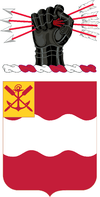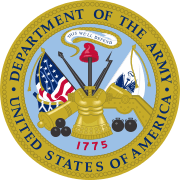4th Engineer Battalion (United States)
| 4th Engineer Battalion | |
|---|---|
|
Coat Of Arms | |
| Active |
31 December 1861 – 21 September 1921 24 July 1922 – 19 February 1946 6 July 1948 – 15 December 2004 18 October 2006 – Present |
| Country |
|
| Branch | US Army Corps of Engineers |
| Role | Combat engineering |
| Battalion Headquarters | Fort Carson, Colorado |
| Nickname | Vanguard of the 4th Division |
| Motto | Volens Et Potens (Willing and Able) |
| Engineer Corps Colors | Scarlett and White |
| Engagements |
World War I World War II Vietnam War War on Terror |
| Decorations |
Presidential Unit Citation (Army) Meritorious Unit Commendation (Army) Belgian Fourragere 1940 Republic of Vietnam Cross of Gallantry with Palm Republic of Vietnam Civil Action Honor Medal Valorous Unit Award |
| Insignia | |
| Distinctive Unit Insignia |
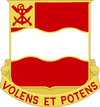 |
The 4th Engineer Battalion (the Vanguard of the 4th Division) is an engineer battalion of the United States Army. It is made up of combat engineers. The unit saw action in the American Civil War, World War I, World War II, Vietnam War, and the Global War on Terrorism, to include Operation Iraqi Freedom and Operation Enduring Freedom. The 4th Engineer Battalion is currently deployed in Afghanistan as Task Force Iron Fist in support of the War in Afghanistan.[1]
Coat of arms
Blazon
- Shield: Gules, a fess wavy Argent, on a canton Or an anchor debruised by two oars in saltire of the field.
- Crest: From a wreath Argent and Gules a dexter cubit arm mailed Proper grasping four arrows Gules armed and feathered Argent.
- Motto: “VOLENS ET POTENS” (Willing and Able).
Symbolism
- Shield: Scarlet and white are the colors of the Corps of Engineers.
The wavy fess alludes to the outstanding feat accomplished by the organization in World War I, in which the regiment bridged the Vesle under heavy fire, making possible the forcing of the passage by the Division.
The yellow canton, representative of the color of the Engineers' facing when the old companies of the regiment were organized in 1861, refers to the 2nd Engineers, from which the 4th Engineers was organized in 1916.
The device on the canton was the badge of the Engineers and Pontoniers of the American Civil War.
- Crest: The mailed hand and arrows are indicative of the combat capabilities of the unit, the number of arrows corresponding to the numerical designation of the battalion.
- Background: The coat of arms was originally approved for the 4th Engineer Regiment on 21 January 1921.
It was redesignated for the 4th Engineer Battalion on 4 December 1940.
Distinctive unit insignia
- Description: A Gold metal and enamel device 1 1⁄8 inches (2.9 cm) in height overall consisting of a shield blazoned: Gules a fess wavy Argent; on a canton Or an anchor debruised by two oars in saltire of the field. Attached below the shield is a Gold scroll inscribed "VOLENS ET POTENS" in red letters.
- Symbolism: Scarlet and white are the colors of the Corps of Engineers.
The wavy fess alludes to the outstanding feat accomplished by the organization in World War I, in which the regiment bridged the Vesle under heavy fire, making possible the forcing of the passage by the Division.
The yellow canton, representative of the color of the Engineers' facing when the old companies of the regiment were organized in 1861, refers to the 2nd Engineers, from which the 4th Engineers was organized in 1916.
The device on the canton was the badge of the Engineers and Pontoniers of the Civil War.
- Background: The distinctive unit insignia was originally approved for the 4th Regiment Engineers on 18 February 1927.
It was redesignated for the 4th Engineer Battalion on 5 December 1940.
Formation and Early History
The battalion was organized 31 December 1861 in the Regular Army at Washington, D.C., from new and existing companies of engineers as a provisional engineer battalion. The battalion participated in major campaigns and battles in the American Civil War to include: Peninsula Campaign (March 1862), Battle of Antietam (September 1862), Battle of Fredericksburg (December 1862), Battle of Chancellorsville (April 1863), Battle of the Wilderness (May 1864), Battle of Spotsylvania Court House (May 1864), Cold Harbor (June 1864), Siege of Petersburg (June 1864-March 1865), and the Confederate surrender after the Battle of Appomattox Court House (April 1865). It was constituted 28 July 1866 as the Battalion of Engineers. The battalion also participated in the War with Spain at the Battle of Santiago in July 1898 and the Philippine Insurrection in 1899. The battalion was then expanded 14 March-7 June 1901 to form the 1st and 2nd Battalions of Engineers.
The Great War and World War II
The 2nd Battalion of Engineers was further expanded, reorganized and redesignated during July 1916 as the 2nd Regiment of Engineers. The unit was expanded yet again during May and June 1917 to form the 2nd, 4th, and 5th Regiments of Engineers. The 4th Regiment of Engineers was redesignated as the 4th Engineers in August 1917 and was, thereafter, assigned to the 4th Division in January 1918. The 4th Engineers deployed to France in support of the Western Front by participating in campaigns within the European theater. Such campaigns included: Aisne-Marne (Summer 1918), Battle of St. Mihiel (September 1918), Meuse-Argonne Offensive (Fall of 1918), and November 1918 in Alsace-Lorraine. After occupation service, the unit was inactivated in 1921 at Camp Lewis, Washington. Between 1927 and 1933 the unit was reassigned to support the 6th Division and six years later it was redesignated as the 4th Engineer Battalion activated (less Company A, which activated 24 July 1922 at Fort Bragg, North Carolina) 1 June 1940 at Fort Benning, Georgia. Reorganizations and redesignations led first as the 4th Engineer Motorized Battalion (September 1942) then the 4th Engineer Combat Battalion (August 1943) were formed. In January 1944, the battalion arrived in England to prepare for deployment to Normandy, France. On June 6, 1944 the battalion deployed to Normandy as part of Operation Overlord. After the Normandy invasion, the battalion continued across western Europe and participated in campaigns such as Northern France, the Rhineland, Ardennes-Alsace, and Central Europe. Soon after World War II ended, the unit was inactivated 19 February 1946 at Camp Butner, North Carolina. This did not last long however, with reactivation on 6 July 1948 at Fort Ord, California and subsequent redesignation as the 4th Engineer Battalion in June 1953.
Vietnam War
The 4th Engineer Battalion was activated for deployment in July 1966 to the Vietnam War from Fort Lewis, Washington as the vanguard of the 4th Infantry Division, and assigned to support the 1st Brigade 8th Infantry. Company A was sent to Pleiku, Vietnam via ship on the MST Gordan and later units on the Buckner, flying from SEATEC on 7 July 1966, to Oakland Naval Shipyard, and then transported to, via San Diego to pick up 3500 Marines, then on to Japan, (Sgt E-6 and above in Japan, overnight some got passes), and then to Qui Nhon, we were able to secure a palette of beer, and mess food, and other misc supplies and trucked to Pleiku by our squad platoon of dump trucks. We were then airlifted to Camp Holloway, Pleiku, by Caribou Aircraft. Then the battalion was driven by rough terrain buses to Dragon Mountain and into a huge area of four square miles, in for personnel and heavy equipment, beached landed and then headed north up Highway 1 and convoyed to Tuy Hoa and built the 2nd Brigade of the 8th Infantry 4th ID Base Camp. The company was then assigned simultaneously, to operations (latterite pit, hard clay like substance, used for road base), at Tuy Hoa, and 350 km back up to order to start securing and building up construction of base camp for the arrival of the 4th Infantry Division in August 1966. This is the origin of it being named the "Vanguard of the 4th Division". This base camp was named Camp Enari after the 1st officer, Lieutenant Enari, to be killed.
Further operations
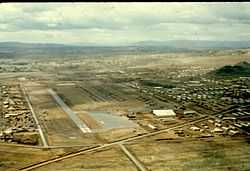
The CO A, 4th Engineer Battalion convoyed back down to Qui Nhon from Pleiku, then via LST transport Pleiku, Camp Enari, Hwy 1, Qui Nhon, QL 6B, La Hai, and Phu Yen Province. There, it performed daily mine sweeps, repaired roads and bridges on Highways 1, 14 & 19 through the Central Highlands. After it had completed these tasks, the unit returned to Camp Enari. This task included mine-clearing and "jungle busting" with HD 16 Allis Chambers Bulldozers (replaced by the D-7E Caterpillar Bulldozers and M-48 tanks equipped with blades.
Later, the individual companies B, C, D, E, and F, of the battalion were assigned to ground operations in Tuy Hoa, Jackson Hole Vietnam, LZ Oasis, Đắk Tô, Đức Cơ, Plei Me, Kontum, Ban Me Thuot, Ia Drang Valley and Đức Phổ. Various Landing Zones (LZs) were built by the 4th Engineers: LZ Marylou near Kontum, LZ Oasis, and LZ Jackson Hole, LZ Duc Co, LZ Baldy, and others. Their operations there included activities concerning Tuy Hoa, La Hai, Polei Kleng, Bong Son and its enormous bridge, and the coastal town of Đức Phổ. Captain Knutzen, a West Point graduate, led the unit through a one-year tour with only one soldier reported as killed in action. The 4th Engineer Battalion participated in the intense combat of Tet 1968. It is often said that engineers are really "infantrymen with additional picks and shovels." This was certainly the case for the 4th Combat Engineers Battalion in Vietnam.
Company A, 4th Engineer Battalion received two Presidential Unit Citations, 20 May 1967 Duc Co and Nove 19–23 1967 Dakto, they also received the Meritorious Unit Citation and Unit & Individual Vietnamese Gallantry Medals. They were shipped on the USMS Walker, from Oakland Terminal, to San Diego, to Kodak Japan, overnight stop, and landed at Qui Nhon, and in-country from, 7 July 1966 to 6 June 1967. The colors were brought to their new home at Ft. Carson in 1971, and remain there, with CO A being deactivated in 12 December 2004.
Withdrawal
Some personnel of A Company departed Vietnam 30 days early and the rest with the rest of the battalion to follow within weeks, on 6 June 1967. The 4th Engineer Battalion was reflagged December 2004, at Ft. Carson, Inactivated 15 December 2004 at Fort Carson, Colorado, and relieved from assignment to the 4th Infantry Division. "A Company" The Vanguard, with two Presidential Unit Citations, with Oak Leaf Cluster, was deactivated, with the other companies reflagged as B, C, D, and F BCT units and with F being deployed to Iraq.
Modern Era
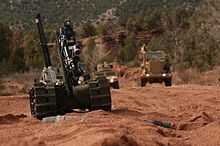
The 4th Engineer Battalion's Headquarters and Headquarters Company was reactivated 18 October 2006 at Fort Carson, Colorado. Additionally, the battalion consists of the 62nd Engineer Company (Sapper), 576th Engineer Company (Clearance), 569th Engineer Company (Mobility Augmentation), and a Forward Support Company. In February 2009, the battalion deployed in support of Operation Iraqi Freedom to Camp Liberty, Iraq. In early March, the battalion was reassigned to support Operation Enduring Freedom, and by late April, the entire battalion had arrived at Kandahar Airfield, Afghanistan. It was there that the battalion designated itself "Task Force THOR" and began route clearance operations across Regional Command South. The battalion supported Operation Enduring Freedom in RC-South for the next 10 months, redeploying to Fort Carson in February 2010.
The battalion's next involvement in the Global War on Terrorism resulted in the 62nd Engineer Company (Sapper) deployment in support of Operation Iraqi Freedom from August 2011 to December 2011, while, simultaneously, the 576th Engineer Company (Clearance) deployment in support of Operation Enduring Freedom from August 2011 to July 2012. The 569th Engineer Company (Mobility Augmentation) deployed in support of Operation Enduring Freedom from February 2012 to February 2013. Upon the 569th Engineer Company's return, the 62nd Engineer Company (Sapper) deployed to Afghanistan in support of Operation Enduring Freedom in February 2013 and await redeployment scheduled around November 2013. The battalion and its Forward Support Company recently deployed to Kandahar, Afghanistan located within Regional Command South in support of Operation Enduring Freedom in June 2013 and awaits redeployment scheduled in March 2014. In August, the 576th Engineer Company (Clearance) deployed to Regional Command West to support Italian operations under Operation Enduring Freedom.
As of August 2013, the 4th Engineer Battalion and its subsequent Engineer Companies, in support of both Operation Enduring Freedom and Operation Iraqi Freedom, currently has 28 months of continuous service in OIF and OEF with a combined total of 37 months during that 28-month period due to having multiple Engineer Companies deployed at the same time. Also, as of August 2013, the 4th Engineer Battalion has accrued more than 95 months of combined deployment time in support of the Global War on Terrorism from 2003 to 2013.
Lineage
| Year | Date | Event |
|---|---|---|
| 1861 | December 31 | Organized in the Regular Army at Washington, D.C., from new and existing companies of engineers as a provisional engineer battalion (constituted 28 July 1866 as the Battalion of Engineers). |
| 1901 | March 14 | Expanded to form the 1st and 2nd Battalions of Engineers (1st Battalion of Engineers—hereafter separate lineage). |
| 1916 | July 1 | 2nd Battalion of Engineers expanded, reorganized, and redesignated as the 2nd Regiment of Engineers. |
| 1917 | May 21 | 2nd Regiment of Engineers expanded to form the 2nd, 4th, and 5th Regiments of Engineers (2nd and 5th Regiments of Engineers—hereafter separate lineages). |
| 1917 | August 29 | 4th Regiment of Engineers redesignated as the 4th Engineer Regiment. |
| 1918 | January 1 | Assigned to the 4th Division. |
| 1918 | May | Unit deployed to France with the 4th Division between, making use of the British Shipping Program. |
| 1919 | August | Unit returned to CONUS with the 4th Division. |
| 1921 | September 21 | Unit Inactivated at Fort Lewis, Washington. |
| 1922 | July 24 | Company A activated at Fort Bragg, North Carolina. |
| 1927 | August 15 | Relieved from assignment to the 4th Division and assigned to the 6th Division. |
| 1929 | September 30 | Company A inactivated. |
| 1933 | October 1 | Relieved from assignment to the 6th Division and assigned to the 4th Division (later redesignated as the 4th Infantry Division) (Company A concurrently activated at Fort Benning, Georgia). |
| 1939 | October 19 | Redesignated as the 4th Engineer Battalion. |
| 1940 | June 1 | Activated (less Company A) at Fort Benning, Georgia. |
| 1942 | September 19 | Reorganized and redesignated as the 4th Engineer Motorized Battalion. |
| 1943 | August 1 | Reorganized and redesignated as the 4th Engineer Combat Battalion. |
| 1944 | January 18 | Departed New York Port of Embarkation. |
| 1944 | January 29 | Arrived in England started to prepare for Deployment. |
| 1944 | June 6 | Unit Deployed to Normandy and entered Combat in the Normandy Campaign. |
| 1944 | July 24 | Normandy Campaign concluded. |
| 1944 | July 25 | Northern France Campaign started. |
| 1944 | September 14 | Northern France Campaign concluded. |
| 1944 | September 15 | Rhineland Campaign started. |
| 1944 | December 16 | Unit was withdrawn from the Rhineland Campaign to engage in the Ardennes-Alsace Campaign. |
| 1945 | January 25 | Ardennes-Alsace Campaign concluded. Unit resumed combat in Rhineland Campaign. |
| 1945 | March 21 | Rhineland Campaign concluded. |
| 1945 | March 22 | Central Europe Campaign started. |
| 1945 | May 11 | Central Europe Campaign concluded. |
| 1945 | July 12 | Unit returned to CONUS and located at Camp Butner, North Carolina. |
| 1945 | August 14 | Unit was located at Camp Butner, which is when the war ended. |
| 1946 | February 19 | Inactivated at Camp Butner, North Carolina. |
| 1948 | July 6 | Activated at Fort Ord, California. |
| 1953 | June 5 | Redesignated as the 4th Engineer Battalion. |
| 1966 | July 7 | Arrived in Vietnam. The Battalion had its headquarters collocated with the 4th Infantry Division at Pleiku. |
| 1968 | March | The Battalion moved its headquarters to Dak To. |
| 1968 | April | The Battalion moved its headquarters back to Pleiku. |
| 1970 | March | The Battalion split its headquarters, with some elements located at Pleiku, with the rest at An Khe. |
| 1970 | April | The Battalion consolidated its headquarters at An Khe. |
| 1970 | December 15 | Unit returned to CONUS. |
| 2003 | April | The Battalion deployed to Iraq in support of Operation Iraqi Freedom. |
| 2004 | February | The Battalion redeployed to Ft. Carson, CO. |
| 2004 | December 15 | Inactivated at Fort Carson, Colorado, and relieved from assignment to the 4th Infantry Division. |
| 2006 | October 18 | Headquarters and Headquarters Company activated at Fort Carson, Colorado (Support Company concurrently constituted and activated). |
| 2009 | February | The Battalion deployed to Baghdad, Iraq in support of Operation Iraqi Freedom. |
| 2009 | April | The Battalion moved to Kandahar, Afghanistan to support Operation Enduring Freedom. |
| 2010 | February | The Battalion redeployed to Ft. Carson, CO, having completed a twelve-month route clearance deployment to Iraq and Afghanistan in support of the Global War on Terror. |
| 2011 | August | The 62nd Engineer Company deployed to Iraq in support of Operation Iraqi Freedom and the 576th Engineer Company deployed to Afghanistan in support of Operation Enduring Freedom. |
| 2011 | December | The 62nd Engineer Company redeployed to Fort Carson, CO after a 5-month deployment to Iraq. |
| 2012 | February | The 569th Engineer Company deployed to Afghanistan in support of Operation Enduring Freedom. |
| 2012 | July | The 576th Engineer Company redeployed to Fort Carson, CO after a 9-month deployment to Afghanistan. |
| 2013 | February | The 569th Engineer Company redeployed to Fort Carson, CO after being deployed 12 months to Afghanistan. Also within the same month, the 62nd Engineer Company deployed to Kandahar, Afghanistan in support of Operation Enduring Freedom. |
| 2013 | June | The 4th Engineer Battalion, its Headquarters and Headquarters Company, and a Forward Support Company deployed to Kandahar, Afghanistan in support of Operation Enduring Freedom. |
| 2013 | August | The 576th Engineer Company deployed to Regional Command West (RC-W), Afghanistan in support of Operation Enduring Freedom.[2] |
Honors
Campaign participation credit
|
|
|
Decorations
See alsoNotes
References
|
